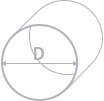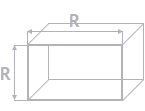Air sock matching
Choosing the air duct shape
Air socks can come in different geometric shapes, such as a circle, a semi-circle, a segment, as well as a triangular or rectangular cross section. This offers a means for them to be used in a variety of facilities, since their shape allows the ducts to be adapted to any of the customer’s requirements.
 Circular |
 Rectangular |
|
 Semi-circular |
 Segment |
 Quarter |
- Circular shape ducts are used in the case that there are no limitations as to the height of the suspension away from the floor/ceiling. The diameter of the duct in this case will be as small as possible for such an air flow.
- Semi-circular shaped ducts are used, as a rule, in facilities with low ceilings. In this case, we can augment the distance from the duct to the work area, which has a positive effect on the air’s distribution. Also, an option in this instance is the use of segment-shaped ducts.
- Quarter-shaped air ducts find use in offices, conference halls, production facilities, and other types of facilities where ventilation for various reasons cannot be situated at the center of the facility, but rather much be placed along the walls.
- Rectangular-shaped air ducts are usually used for exhaust. Their shape is supported by an aluminum shape frame.
Overall dimensions
The diameter of the ducts that TEXAIR installs ranges from 160 to 2,000 mm. This is, as a rule, enough to distribute an air current of between 200 and 70,000 m³/h.
The interval of the diameters usually corresponds to the spacing of zinc-coated ducts’ diameters for convenience in calculating and replacing metallic ducts for textile ones. Also, adjoining and other sections of air socks are fully compatible with metallic shaped elements.
The length of separate air distribution segments can reach as much as two hundred meters and depends on such parameters as the duct’s material, air flow, and air pressure. The duct is divided up into segments that connect to each other using zippers according to its design.
Shaped elements
The air socks are just as good as metallic ducts when it comes to the flexibility of their installation. TEXAIR conducts an entire spectrum of section-shaped wares necessary to construct lines of any configuration.
 Connection to the air flow equalizer |
 Passage |
 Turn |
 Output/input adapter |
 Blind |
 Branch pipe |
Material selection
Proper selection of the duct’s materials requires data on the purpose of the system (for heating, ventilation, conditioning), the temperature of the air to be supplied, the type of facility, as well as whether any special conditions exist that must be taken into account (high temperature, moisture, clean facility, aggressive environment, etc.). High-quality materials are used for production with foundations and coating of various types (polyester, glass fiber, polyurethane, silicon, etc.). This provides a means to manufacture ducts suitable for operation at any facility, regardless of the specific factors present there or the complexity.
TEXAIR technicians help customers find the necessary choice of material for the duct’s production, taking into account his or her individual requirements.
Distribution of heat energy with continuous air flow
| Types of fabrics | Fabric contents | Air permeability | Quantity of colors | Fabric weight | G1 flammability certificate | Water resistance |
| TEX-Sti | 100% polyester + polyurethane coating | No | 11 | 230 g/m² | >2000 mm | |
| TEX-Stp | 100% polyester | Yes | 11 | 230 g/m² | >2000 mm | |
| TEX-StiF | 100% polyester + internal polyurethane coating | No | 1 | 290 g/m² | Yes | >2000 mm |
| TEX-Lti | 100% polyamide / polyester + internal polyurethane coating | No | 11 | 105 g/m² | >1000 mm | |
| TEX-Ltp | 100% polyamide / polyester | Yes | 11 | 105 г/м2 | ||
| TEX-StAb | 100% polyester | No | 1 | 230 g/m² | >2000 mm | |
| TEX-Fsi | 100% glass fiber + double-sided silicon coating | No | 2 | 570 g/m² | Yes | >3000 mm |
| TEX-Fpu | Glass fiber + double-sided polyurethane coating | No | 2 | 510 g/m² | Yes | >3000 mm |
- TEX-Sti: TEXAIR Standard Impermeable
- TEX-Stp: TEXAIR Standard Permeable
- TEX-StiF: TEXAIR Standard Impermeable Fireproof
- TEX-Lti: TEXAIR light Impermeable
- TEX-Ltp (Light Permeable): light air permeable polyester 100%
- TEX-Lti-RS (Light Impermeable Rip-Stop): ultralight reinforced air impermeable polyester 100%
- TEX-StAb: TEXAIR Standard Antibacterial
- TEX-Fpu: TEXAIR Fiber Polyurethane
- TEX-Fsi: TEXAIR Fiber Silicone
Choice of duct color
The TEX-Lti and TEX-Sti materials are the most widespread and are used in the majority of projects. They are available in 12 different color options although customers mainly go with white or bright grey.
Fabrics with special properties are available in a limited color range.
White
Beige
Yellow
Orange
Black
Red
Light grey
Green
Blue
Dark grey
Light blue
lndividual*
Types of fabrics by facility categories
| Types of fabrics | Tex-Lti | Tex-Sti | Tex-Stp | Tex-StAb | Tex-Fpu | Tex-Fsi |
| Food industry | + | + | + | + | ||
| Production | + | + | + | + | + | |
| Logistics / Warehouses | + | + | + | |||
| Malls | + | + | + | |||
| Public buildings | + | + | + | + | + | |
| Clean facilities | + | + | ||||
| Sports facilities | + | + | + | + | ||
| Animal/Bird husbandry | + | + | + | + | ||
| Pools | + | + |
TEXAIR ducts materials’ chemical resistance
| Chemical substance | Air duct material | Material coating | ||
| Polyether (polyester) | Polyamide | Polyurethane (PUR) | Silicon (VMQ) | |
| Acetone | – | * | – | * |
| Formylic acid | 10% | – | / | * |
| Ammonia | – | 20% | / | + |
| Benzine | + | + | + | + |
| Benzol | + | – | + | – |
| Brake fluid | + | 60ºС | / | + |
| Butane | / | + | / | – |
| Butyl alcohol | + | + | / | – |
| Calcium chloride | + | + | / | / |
| Benzine chloride | + | * | – | – |
| Diesel oil | + | / | + | * |
| Vinegar acid | 40% | – | / | – |
| Formaldehyde | 30% | + | / | + |
| Freon 113 | + | / | / | / |
| Fruit juice | + | + | + | + |
| Glycerin | + | + | + | + |
| Fuel oil | + | + | + | * |
| Hydraulic oil | + | + | / | * |
| Potassium alkali | – | – | / | / |
| Potassium chloride | + | + | + | + |
| Potassium hydroxide | – | / | – | * |
| Flax seed oil | + | + | + | * |
| Methanol | – | * | / | + |
| Dichloromethane | – | – | – | – |
| Lactic acid | + | 10% | / | / |
| Mineral oils | + | + | + | + |
| Motor oils | + | + | + | + |
| Sodium carbonate | + | + | / | / |
| Sodium chloride | + | 10% | + | + |
| Sodium hydroxide | – | / | – | * |
| Sodic alkali | 40% | 10% | / | – |
| Hydrogen nitrate | 10% | – | – | – |
| Hydrochloric acid | + | – | – | / |
| Lube oil | + | + | + | + |
| Carbon bisulphide | – | * | / | – |
| Sulphuric acid | 70% | – | / | 25% |
| Soap solution | + | + | * | + |
| Cleaner | / | / | * | + |
| Terebenthene | + | + | / | – |
| Tetrachlorolnethane | + | * | – | – |
| Toluene | + | + | – | – |
| Trichloroethylene | – | – | – | – |
| Water (any) | + | + | + | + |
| Tartaric acid | + | + | + | + |
| Dimethylbenzene | + | + | – | – |
| Zinc sulphate | + | / | / | + |
| Citric acid | + | 10% | / | + |
+ stable in any concentration
% stable in a maximum % concentration
°C stable up to a maximum temperature
* conditionally stable
– unstable
/ no data



